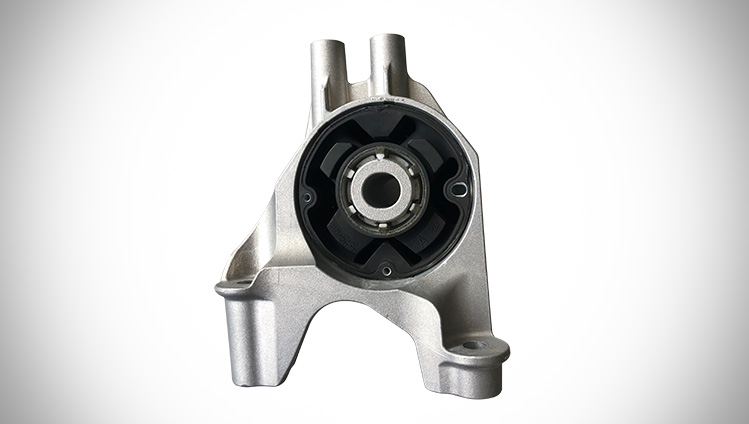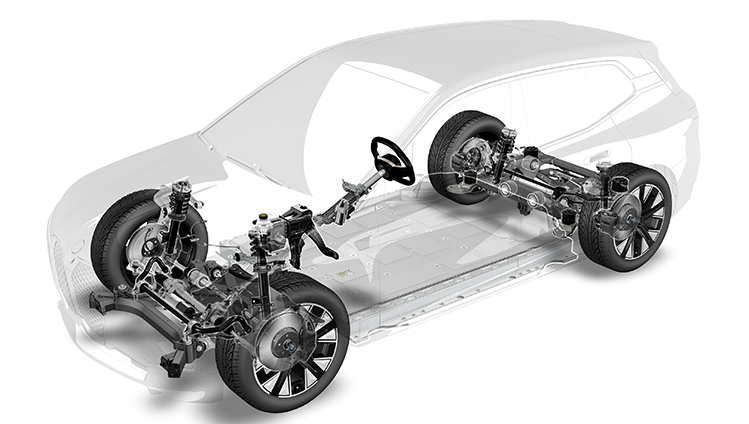
Anyone who has ever run their finger along the rim of a wine glass knows the bright sound it makes. A barely perceptible jerk of the finger causes the glass to vibrate. The steady vibration of the glass then produces those sound waves that we hear. The same thing happens again and again in our everyday lives: small vibrations make objects sound – sometimes more, sometimes less perceptible.
"This phenomenon also occurs in cars: the engine vibrates and causes other resonant surfaces in the vehicle to oscillate," explains Peter Koch, who is responsible for the development of engine mounts at Continental. "In the case of internal combustion engines, such discords have not been a major issue up to now – especially at low speeds and in the high-frequency range. The already loud powertrain simply drowned out most of the noise. It's a different story with the electric engine: if its vibration causes vehicle parts to oscillate, it usually results in an annoying drone, whistle or buzz." The challenge with the e-car is therefore to mount the engine in such a way that it does not transmit any disturbing vibrations to the vehicle.
On their way to the electrified drive, manufacturers recognized early how important vibration-optimized engine mounts are for acoustic comfort in electric cars, and BMW Group is no exception. For the current platform of purely electrically driven vehicles, the Munich-based company relies on the support of Continental. The BMW iX model was launched in the summer of 2021: the luxury SUV has two electric engines, one in the front and one in the rear.
German-French ensemble resonates in unison
The path to low-vibration mounts for these engines began in 2018, when the Continental team in Rennes, France, started developing the mounts. Peter Koch acted as an interface between his French colleagues and the customer from Bavaria. "Such a cultural exchange is always enriching: the philosophies and approaches to such a project naturally differ from region to region. But when the end result is a good product, everyone is proud of what they have achieved in the same way," says Koch with a wink.

Reaching goals faster virtually
In Rennes, the path to this good product began virtually. The engineers there first created virtual prototypes with the help of CAE software. CAE stands for computer aided engineering. However, the experts create more than just a digital blueprint: The prototypes can be tested almost as intensively as real models with the help of computer simulations. This approach is called the finite element method, or FEM for short. The development time is shortened enormously because real prototypes are now built on the basis of the virtual models that were able to prove in the digital stress test that they tame the high-frequency vibrations.
This is because the virtual models can also be used to clarify important questions at an early stage: How do different rubber compounds in the mount react at different speeds of the electric motor? At which points is the load caused by the vibrations particularly high? Which modified material mix would counteract such stress and thus extend the service life of the mount? At which points could weight be reduced particularly effectively? And, of course, which holistic structure – design and material – would be particularly effective in capping the path that the high-frequency vibration wants to take?
"The virtual approach is convenient for the developers: if they change the design or the material at one point, for example, they can see in real time what the consequences of this change are. This allows them to try out a route that they might not have taken with a real prototype," says Koch. "Both in terms of time and economics, this is more sustainable – which ultimately benefits manufacturers as much as their end customers."
Matching mounts with the modular system
Continental mounts will also be used in other models of BMW Group's current E-generation, such as the i4. For this purpose, the team in Rennes has developed a modular system with which suitable mounts can be quickly pieced together depending on the model.

In principle, an engine is usually supported by three to four mounts. Each consists of an aluminum core and an enclosing rubber element. Everything is girded in a stable sleeve. The core is attached to the engine, while the outer sleeve – to put it simply – is attached to the rest of the vehicle. The rubber element in between supports the engine elastically and isolates it acoustically from the vehicle. On the material side, several rubber and plastic compounds form the basis here, which can be combined or adapted in different ways depending on requirements.
However, the focus is not only on high-frequency behavior and service life, but also on weight. "In automotive engineering, every gram counts nowadays," explains Koch. "That's why we have consistently replaced the metallic outer sleeves in the mounts with lighter, but equally resilient elements made of high-performance polyamide." Around 80 percent of the various components can be used across models in the modular system. The remaining 20 percent can be customized: For some vehicles, for example, the stiffness of the rubber plays a more important role, while for others, the material needs to be more flexible.
One location for everything: from the idea to production
The French Continental team not only provided the engineering services for the design of the mounts, but is also responsible for their production. A fully automated production plant was developed in-house for this purpose as well and has been running at full speed for months. "Development and production are combined under one roof in Rennes. In addition, most of the materials for the mounts – especially the rubber and polyamide – are made by Continental. The vertical integration is enormous. For our customers, this has the nice side effect that we can respond even faster and more flexibly to their wishes – even in future projects," says Koch. Therefore, from now on, the sonority of modern automobiles will come from France, just like the pleasure in two wine glasses clinking.